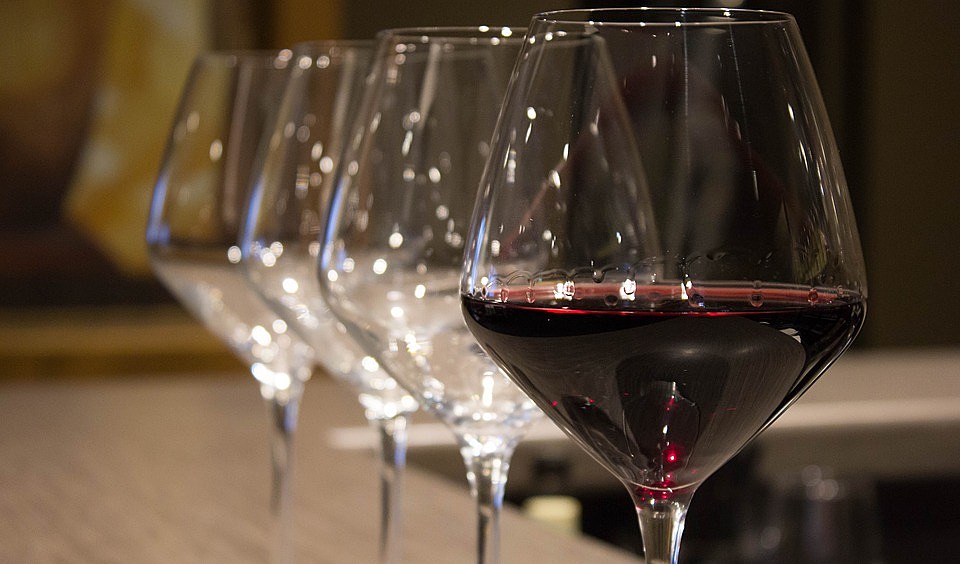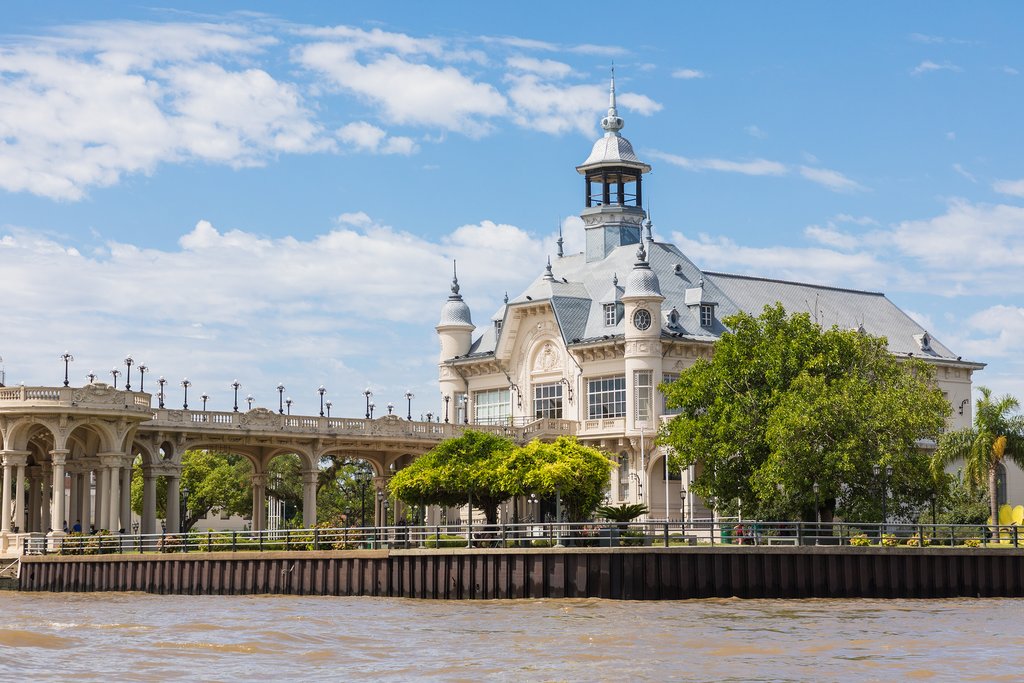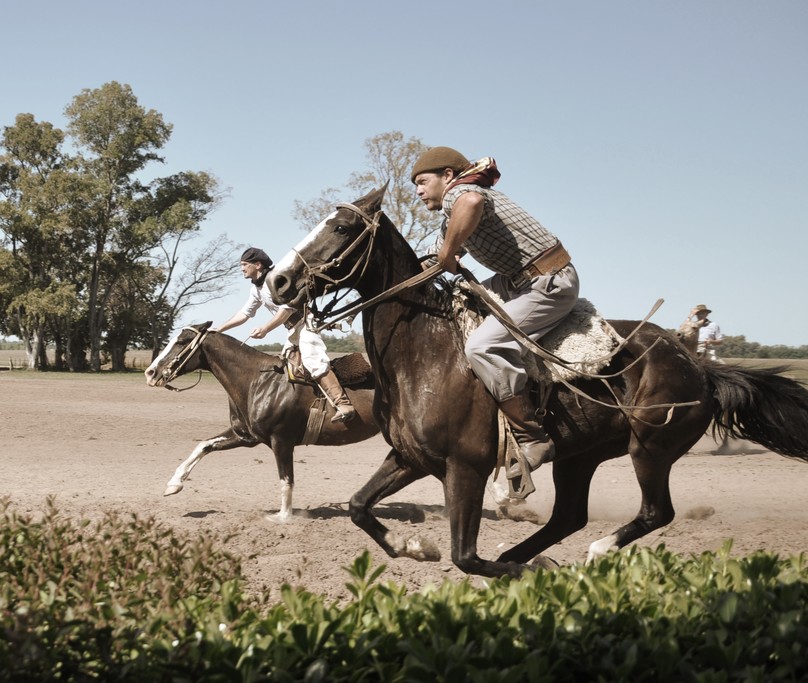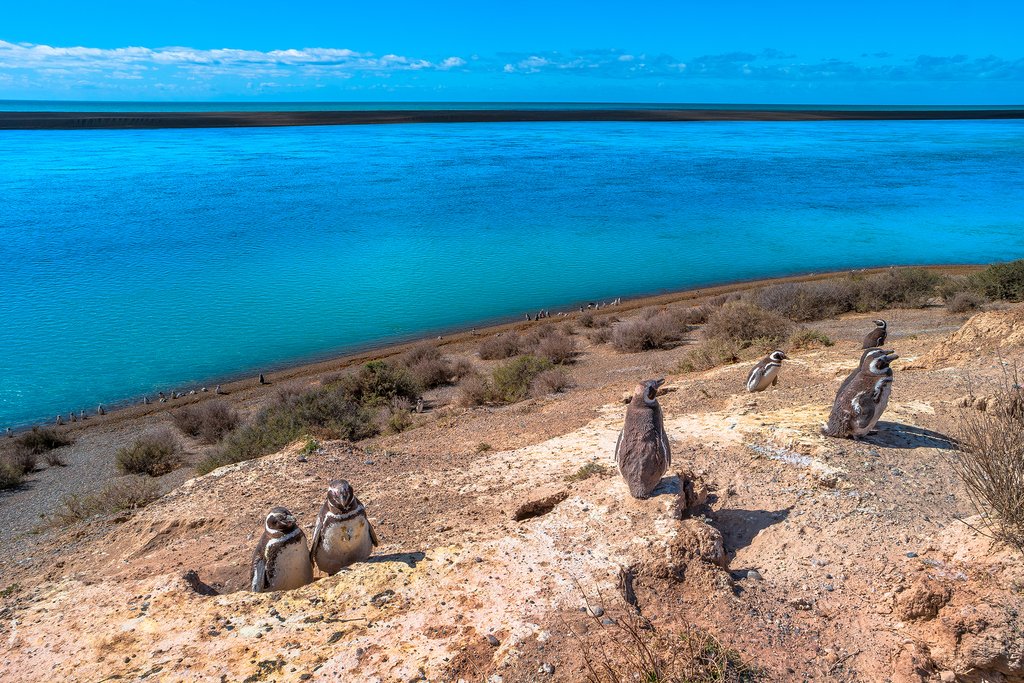Highlights
- Take a cooking class in Buenos Aires and learn the secrets to delicious Argentine cuisine
- Snorkel with sea lions and walk with penguins in Patagonia
- Visit a working Argentine estancia (ranch)
Brief Itinerary
| Day | Highlights | Overnight |
|---|---|---|
| Day 1 | Arrival in Buenos Aires - Explore the City | Buenos Aires |
| Day 2 | The Argentine Culinary Experience | Buenos Aires |
| Day 3 | Half-Day City Tour - Dinner & Tango Show | Buenos Aires |
| Day 4 | Full-Day Excursion to Tigre | Buenos Aires |
| Day 5 | From Buenos Aires to Puerto Madryn | Puerto Madryn |
| Day 6 | Península Valdés and Whale Watching | Puerto Madryn |
| Day 7 | Penguin Colony at Punta Tombo | Puerto Madryn |
| Day 8 | Snorkeling with Sea Lions in Puerto Madryn | Puerto Madryn |
| Day 9 | Fly from Puerto Madryn to Buenos Aires | Buenos Aires |
| Day 10 | Gaucho Experience at Estancia Santa Susana | Buenos Aires |
| Day 11 | Buenos Aires Full-Day Bicycle Tour | Buenos Aires |
| Day 12 | Goodbye Buenos Aires! |
Detailed Itinerary
Day 1: Arrival in Buenos Aires - Explore the City

Welcome to Argentina! Renowned as the "Paris of South America," and the "Queen of El Plata," the capital city of Buenos Aires is defined by passion. This is exemplified in the rich tango heritage and its citizens' limitless enthusiasm for fútbol (soccer), which is far and away the country's most popular sport.
When you arrive at the airport, your driver will be waiting to take you in a private car to your hotel where you can relax after a long flight. But make no mistake: the city will beckon you. So after a quick recharge, be sure to venture out into the welcoming arms of Buenos Aires and explore. The best starting point would be the city center.
Suggested activities include:
-
Visit the Obelisco, which might be the most famous icon of the city. This obelisk (which even Argentines admit is a little too reminiscent of the Washington Monument) is worth a visit for its location alone. It sits right in the middle of Avenida 9 de Julio, which boasts a whopping 16 lanes, making it the widest city street in the world.
-
Stop by the Teatro Colon, one of South America's premier opera houses. The horseshoe-shaped gallery features 2,487 seats and incredible acoustics. Even if you plan on taking a tour or catching a show here on another day, it's always breathtaking to pass by its exterior. The Colon's neoclassical facade has been the face of one of the most handsome buildings in Buenos Aires since its opening in 1908.
-
Stroll Puerto Madero, an upscale waterfront neighborhood adjacent to downtown. Puerto Madero may be the "new money" finance center of Buenos Aires, but it's also one of the most pleasant walking areas in a city famous for its walking areas. A romantic stroll involves walking over the canal on the Puente de Mujer ("Woman's Bridge") at sunset.
- Dine at an Argentine steakhouse or parilla. When night falls and dinnertime arrives, do like the locals and enjoy a thick, juicy steak (Argentina has some of the best beef in the world) drizzled with the nation's famous chimichurri (a garlic, herb, and vinegar sauce). Know that Buenos Aires is a culture that thrives after dark, and it's not uncommon for locals to have dinner well past nine in the evening, especially on weekends.
Day 2: The Argentine Culinary Experience

To truly get to the heart of Argentine culture, you must do so one bite at a time and one sip at a time. Because while Argentine cuisine may be defined by its beef, a closer inspection of the foods of this nation reveals a more eclectic array of dishes. And Buenos Aires, hotbed of activity that it is, is the perfect place to learn about this culinary heritage in a fun and entertaining way. Enter The Argentine Experience, a convivial gastronomic odyssey that celebrates great Argentine food and wine.
Hosted in the trendy neighborhood of Palermo, guests at this unique "dinner party" share a table while enjoying gourmet food and the country's famous wine (such as the Malbec varietal). Professional hosts guide you through the evening and explain the uniqueness of Argentine culture and how it reveals itself in the nation's food. You'll learn how to seal empanada dough using the traditional repulgue folding technique and how to make alfajores (delicious Argentine cookies). You'll also learn how to prepare your own mate, an herbal tea that is the lifeblood of the country.
The evening begins with you preparing three different kinds of wine cocktails as well as some delicious tapas to pair with them. As you progress through the night you'll also try different boutique wines from the house cellar. By the time the experience ends, you will have enough first-hand knowledge of the traditional food and drink of this country to practically be considered an Argentine gastronomic expert!
Day 3: Half-Day City Tour - Dinner & Tango Show

One great way to experience Buenos Aires is to do so on foot. So after a fortifying breakfast prepare yourself for some walking and sightseeing throughout this European-inspired metropolis with the aid of an English-speaking guide.
Some highlights of a walking tour around Buenos Aires include:
- Plaza San Martín, located at the end of downtown's commercial pedestrian thruway, Florida Street. This leafy plaza, anchored by a majestic ombú tree, is named after one of the heroes of Argentina's independence movement, General José de San Martín.
- Plaza de Mayo, which is Buenos Aires' main square and home to Argentina's Presidential Palace. The plaza is the site of some famous events, including the May Revolution of 1810 that kicked off this former Spanish colony's quest for independence. The famous Casa Rosada (or "Pink House," as the Presidential Palace is known), is also rife with history. It's on the front balcony that dictator Juan Perón made some of his most famous speeches with his glamorous wife, Evita, at his side. Ultimately it was she who won the hearts and minds of the Argentine people.
- Metropolitan Cathedral, is the principal Catholic church in the city and another historic building that also faces the Plaza de Mayo. It was consecrated in 1791 but its earliest origins date back to the late 16th century when a humble chapel first sat on the current site.
- Puerto Madero, whose shimmering office towers and central canal make this one of the most elegant neighborhoods in the city. Some upscale restaurants can be found here, as can the Puente de la Mujer, a bridge whose sleek and sensual lines define its title of "Woman's Bridge."
- Barrio San Telmo, which is BA’s oldest neighborhood and boasts a vibrant tango and arts scene. Its antique markets, cobbled streets dotted with faroles (French streetlamps), and old brick buildings with wooden balconies all add to the uniquely bohemian atmosphere. Sundays are especially abuzz with activity as the main street market comes alive around Plaza Dorrego.
- Barrio La Boca is a well-preserved historic neighborhood that's nearly as old as San Telmo. The area is known for La Bombonera, the home stadium of one of two principal soccer teams in the city: Boca Juniors. It's also home to colorful Caminito Street, a pedestrian zone teeming with old restaurants and tanguerías.
In the evening, it's time for "dinner and a show" of the highest order. You'll savor the hallmark dishes of Argentina while enjoying the most spectacular tango show in Buenos Aires. As the deft performers move to the music of love, sorrow, and passion, you'll dine on flaky empanadas, succulent steak, and decadent dulce de leche (vegetarian options available).
But the night doesn't end with the meal. After dinner, more professional dancers will take part in a show-stopping performance of traditional Argentine folkloric music.
Day 4: Full-Day Excursion to Tigre

Today you will travel up the Río de la Plata to the point it converges with the Paraña River Delta, which is comprised of a series of islands about an hour north of Buenos Aires. During the boat journey, take the time to enjoy views of the B.A. city skyline from the deck. Upon arrival at the delta, you will then enter the network of freshwater canals and sail among the many islands that make up this unique region.
The main port on these canals is in Tigre, a Venetian-style village whose relaxed nature and small-town charm stand in stark contrast to Buenos Aires' bustling energy and expansive metropolis. This is where you'll spend the better part of the day. You'll have the freedom to stroll the waterfront, stop in at the cafes and bistros, and otherwise enjoy this gem of B.A.'s provinces any way you see fit.
Suggested activities include:
- Browse Puerto de Frutos. Right on the water, you'll find the "Port of Fruits," a mazelike network of craft markets, produce stalls, artisanal goods, and even garden centers. You're sure to find the perfect snack or souvenir to appeal to your tastes and suit your interests.
- See the town on a tour bus. The Bus Turistico is a hop on/hop off tour bus that covers the basic highlights of Tigre as it drives along the waterfront. The total circuit lasts about an hour and is a quick and relaxing way to get to know this town.
- Visit Tigre's museums. Some of the town's museums are covered on the Bus Turistico. However, if you opt to explore Tigre on foot, you can see them at your own pace. the Museo de Arte is the most popular, as it's housed in the grandest building in town: the Belle Epoch-inspired Tigre Club. What used to be an exclusive hotel and country club in the early 20th century now houses an impressive collection of Argentine artworks that span two centuries. Other highlights include the Naval Museum as well as the Museo de Mate. The latter is a fun little museum that offers an overview of mate (the tea-like herb cultivated in the Paraná region of the country). It showcases some mate paraphernalia and even offers tastings at their "mate bar."
After a full day spent discovering this evocative town, you'll hop on a train back to Buenos Aires. Your tour officially ends at the Retiro station, back in the city.
Chat with a local specialist who can help organize your trip.
Day 5: From Buenos Aires to Puerto Madryn

Today our private transport will pick you up from your hotel and take you to Aeroparque Airport, located near the city center, for your flight to Puerto Madryn. This is the gateway to Argentine Patagonia.
Puerto Madryn sits on the Golfo Nuevo (New Gulf), on northern Patagonia's Atlantic shore. The waters immediately offshore of this city are home to an abundance of marine mammals, including the southern right whale, which breeds in the area from May to December.
Puerto Madryn is most famous for being the gateway to nearby Península Valdés, a UNESCO World Heritage Site and the best place to view a variety of animals in their natural habitat, including sea lions, penguins, guanacos, whales, and orcas. Also near to Puerto Madryn is Gaiman, a small historic town founded by Welsh settlers in 1875. Gaiman has preserved many of its Welsh traditions, which is evident in the tea shops, chapels, and gardens found throughout town.
Upon arrival at Puerto Madryn, a driver will meet you and you'll transfer to the hotel. If you have the energy after your flight, feel free to stretch your legs with a stroll around this tranquil city. It's a safe, walkable community and there is a charming waterfront promenade here lined with cafes and restaurants with patio seating and ocean views. You can also make the short trip to Gaiman and enjoy a spot of afternoon tea.
Day 6: Península Valdés and Whale Watching

Today a driver will pick you up at your hotel for your journey to Península Valdés. The first stop will be at the Istmo Ameghino Interpretation Center, which will act as a useful primer for your foray into this unique eco-system. Through various educational exhibits, you'll gain insight into the different types of fauna that call the peninsula home. There's even a lookout tower here featuring stunning views of the Golfo Nuevo and the Golfo San José.
After visiting the interpretation center you'll continue to Puerto Pirámides. This is the embarking point for today's oceanic wildlife-watching excursion. After boarding the ship, it will sail along the coast and offer many opportunities for wildlife spotting. Keep your eyes peeled for sea lions and (if you're lucky) right whales and killer whales. You'll even pass a local lighthouse that epitomizes all the seafaring splendor and rugged coastal beauty for which Patagonia is deservedly famous.
Even after the boat ride, your day isn't over yet. On the way back to Puerto Madryn you'll pass some salt flats as well as Isla de Pájaros (Bird Island), an island abounding with different avian species like cormorants, egrets, rheas, and flamingos. Then, around 6 pm, the tour ends and you will return to the hotel.
Day 7: Penguin Colony at Punta Tombo

Today you will embark on a tour down the Atlantic coast that culminates in one of the most incredible destinations in Patagonia: Punta Tombo. This tiny protected area (just 0.8 square miles), is home to the largest colony of Magellanic penguins in Latina America.
A driver will meet you at your hotel and transfer you to Puerto Rawson, a fishing village located about 50 km (31 miles) south of Puerto Madryn. Here you will board a ship and start the tour. As you head down the Patagonian coast, be sure to keep an eye out for black-and-white-colored Commerson dolphins, which are regarded as the smallest dolphin species in the world.
The tour will continue down to Punta Tombo, where you'll find the aforementioned penguin colony. Exact estimates of how many Magellanic penguins live here vary, but keep this whopper of a stat in mind: at one point it was home to over a million. The population might be near that figure even today, as everywhere you look you'll find penguins, penguins, and more penguins. You'll even be able to tour the area on foot and stroll alongside these waddling critters. As you walk, you'll almost be able to reach out and literally touch them, such as the density of their population (but alas, this is not allowed ).
Afterward you'll transfer back to your hotel.
Day 8: Snorkeling with Sea Lions in Puerto Madryn

There are only a few places in South America where you can swim with sea lions in their natural habitat. Puerto Madryn is one such place. In the morning a guide will pick you up at your hotel and transport you to their office where you will change into your swimwear. You'll then board a boat at Puerto Pirámides, on Península Valdés, and depart for a nearby bay, which is full of sea lions.
Upon arrival, it's time to hop in the water (wetsuits and equipment will be provided). If you're feeling apprehensive, there's no need to be. Sea lions are curious by nature and will swim up and offer a friendly hello. Also, a guide will be there every step of the way to offer specific instructions about what to do when a sea lion approaches. It's nothing short of an unforgettable experience.
Day 9: Fly from Puerto Madryn to Buenos Aires

A driver will meet you at your hotel and transfer you to the airport where you'll catch your flight back to Buenos Aires. You'll then have the rest of the day to relax in your hotel or get out and visit any of the city sites you might have missed thus far.
If you're feeling peckish then maybe visit one of B.A.'s many panaderias (bakeries), where you can indulge in a medialuna (half-moon-shaped pastry) or famous alfajore (cookie with dulce de leche). Perhaps while away the afternoon hours on a patio table at one of the city's many coffee houses. Buenos Aires is proud of its café culture, and there's no better vantage point in which to do some good old fashioned people watching than at one of the many options in the city.
For a little piece of B.A. history, be sure to stop in at Café Tortoni. This café has been a city institution since it opened all the way back in 1858. So come for a coffee and a churro dipped in dulce de leche, and relish the opulence and history.
Day 10: Gaucho Experience at Estancia Santa Susana

Just as North Americans has their cowboys, Argentines have their gauchos. This frontier culture is strongest in the Pampas (prairies) immediately surrounding the capital, as this is where the country was first settled. Gauchos are national symbols in Argentina, whether it's the real-life horsemen who still exist today, or the folk heroes of epic Argentine poems, like Martín Fierro, whose stories are passed down over the generations.
Today you'll get a real gaucho experience. You'll be picked up in the morning and whisked off to a Santa Susana, a working Argentine estancia (ranch). Here you'll enjoy a welcome reception that includes wine, soft drinks, and empanadas. After a guided tour of the property, you'll do some horseback riding (or perhaps a carriage ride) before settling in for a traditional folkloric music performance—and everyone's invited to get up and dance.
Lunch will be an Argentine asado (mixed grill) paired with even more of the country's fantastic wine. Real gauchos will then showcase their prowess with the bolas—traditional throwing weapons comprised of round weights connected by cords. Their displays will demonstrate how these deceptively simple weapons, when used in the right hands, can be effective at bringing down horses, cows, and even people.
After lunch, you'll be treated to even more entertainment. The gauchos will continue to showcase their abilities, this time as they perform a series feats known as carreras de sortijas ("ring races"). These are typical in gaucho equine competition and showcase these cowboys' great skills on horseback. You will end the day at the estancia with a late-afternoon serving of mate, the popular tea-like infusion that is an indispensable part of Argentine culture.
By the time you transfer back to your hotel in the evening, you can be happy in the knowledge that you've enjoyed a traditional Argentine frontier experience.
Day 11: Buenos Aires Full-Day Bicycle Tour

Today you'll get to experience the city on two wheels as opposed to two feet. On this full-day bicycle tour, you'll zip along the capital and visit every major neighborhood in and around the center of Buenos Aires. Moreover, you'll be doing so on a bambucicleta, an eco-friendly bike handmade from, you guessed it, bamboo. It's the perfect way to engage in responsible tourism around the city.
In the morning you'll meet your guide at the forecourt of the Museo de Armas (weapons museum), located on the south end of Plaza San Martín (transfers not included). Make sure you arrive ready to go, but there's no need to overextend yourself. This excursion is low-to-medium difficulty and is designed more for leisure than endurance. Bikes and helmets are included, as is lunch, bottled water, and insurance.
The first neighborhood you'll hit is Puerto Madero, a mega-port that was once obsolete but has now been transformed into a modern business and finance center. Here you'll visit the Costanera Sur Ecological Reserve, an 865-acre protected area fronting the water, and share a round of yerba mate (a tea that is a cultural touchstone in Argentina). Afterwards, continue south to the La Boca neighborhood and La Bombonera, the home stadium of famous local fútbol (soccer) club, the Boca Juniors. You'll also visit the famous and colorful Caminito Street, which abounds with art, music, and tango dancing.
Then it's off to the oldest area of Buenos Aires, San Telmo, where you'll enjoy a traditional lunch that includes a wide range of carnivorous Argentine delights. Not to worry, though, as the menu can be adapted to accommodate vegetarians. Next, you'll visit nearby Plaza de Mayo and breathe in the rich air of Argentina history.
From the south of the city, you'll now peddle to the north, where the historic working-class barrios give way to the upper-class enclaves of the aristocracy. First it's the Retiro neighborhood, which is famous for its ornate buildings and baroque architecture. This leads to the famous Recoleta neighborhood, whose old French-inspired buildings feature arched doorways and long, yawning windows.
The destination is the Recoleta Cemetery, the oldest and most famous final resting place in the city. Here lies the remains of the most prominent historical figures and the most famous citizens of Argentina. The grand architecture of the family crypts is as impressive as anything anywhere in the world. Note that this is where Eva "Evita" Peron is interned, and you'll visit her family crypt.
Before ending the tour, you'll visit another historic and trendy neighborhood of the city: Palermo, notable for its expansive parks designed by legendary Argentine/French landscape architect Charles Thays.
Bicycle Tour Duration: Full day
Day 12: Goodbye Buenos Aires!

Enjoy your last hours in the cosmopolitan capital of Buenos Aires. At the scheduled time, your driver will pick you up and transfer you by private car to Ezeiza International Airport, where you'll catch your return flight home.


